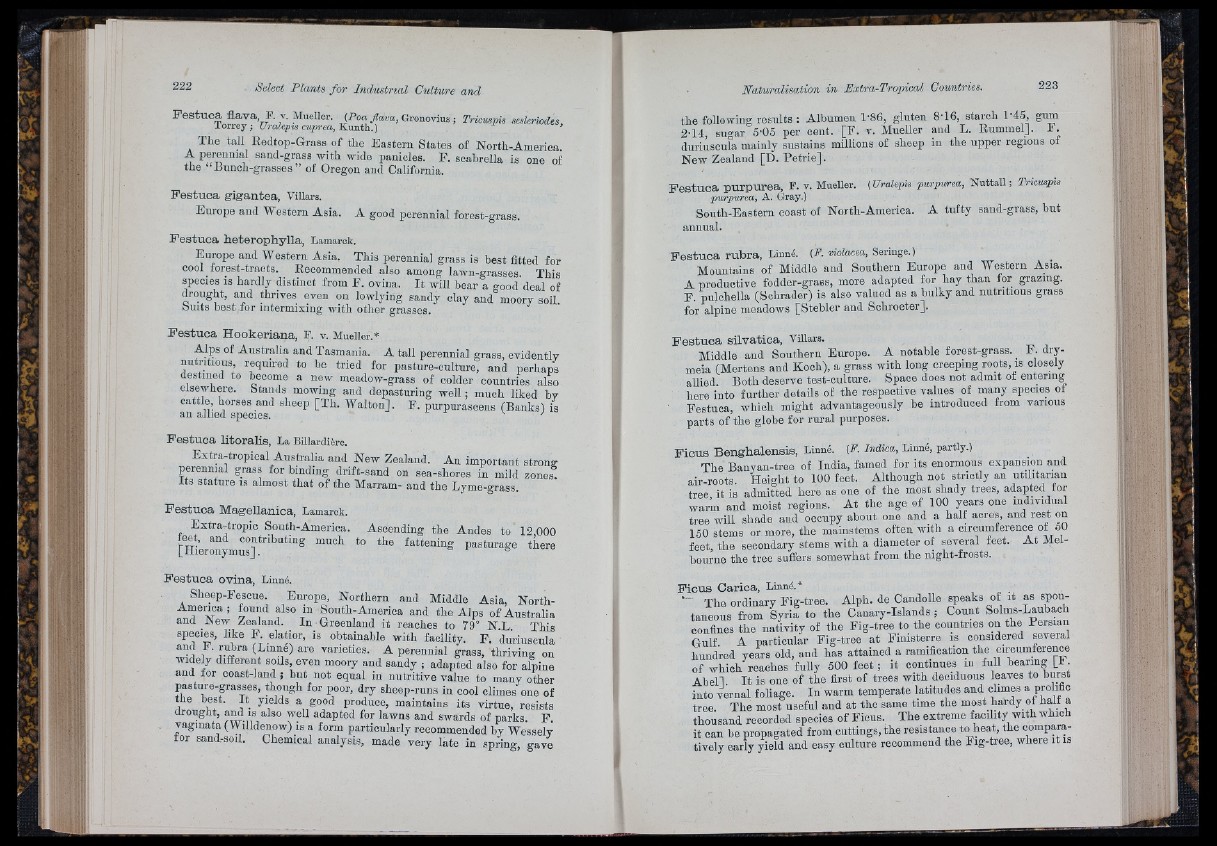
Pestuca flava F. v. Mueller. (Poa flava, Gronovius ; Trieuspis sesleriodes,
lo rre y ; Urahpis cupirea, Kanth.) ’
The tall Eedtop-Grass of the Eastern States of North-America
A perennial sand-grass with wide panicles. F. scabrella is one of
the “ Bnnoh-grasses” of Oregon and California.
Festuca gigantea, Villars.
Europe and IVestern Asia. A good perennial forest-grass.
F e s t u c a h e te r o p h v ll a , Lamarck.
Europe and Western Asia. This perennial grass is best fitted for
cool forest-tracts. Eecommended also among lawn-grasses This
species is hardly distinct from F. ovina. I t will bear a good’deal of
drought, and thrives even on lowlying sandy clay and moory soil,
feints best for intermixing with other grasses.
Pestuca Hookeriana, F. v. Mueller.*
Alps of Australia and Tasmania. A tall perennial grass, evidently
nutritious, required to be tried for pasture-culture, and perhaps
destined to become a new meadow-grass of colder countries also
elsenffieie. Stands mowing and depasturing well; much liked by
cattle, horses and sheep [Th. Walton]. E. purpurascens (Banks) is
an allied species. '
Pestuca litoralis, La Biliardière.
Extra-tropical Australia and New Zealand. An important strong
perennial grass for binding drift-sand on sea-shores in mild zones,
its stature la almost that o f tbe Marram- aud the Lyme-grass.
Pestuca Magellanica, Lamarck.
Extra-tropic South-America. Ascending the Andes to 12,000
[Hieronymui“ *'^
Festuca ovina, Linné.
Sheep-Fescue. Europe, Northern aud Middle Asia, North-
Amerioa ; found also in South-America and the Alps of Australia
and New Zealand. In Greenland it reaches to 79° N L This
species, like F elatior, is obtainable with facility. F . du'riuscula
1 ^ perennial grass, thriving on
widely different soils, even moory and sandy ; adapted also for alpine
and for coast-laud ; but not equal in nutritive value to many other
pasture-grasses, though for poor, dry sheep-runs in cool climes one of
the best. I t yields a good produce, maintains its virtue, resists
drought, aud is also well adapted for lawns aud swards of parks. F .
vagmata ( Willdenow) is a form particularly recommended by Wessely
for sand-soil. Chemical analysis, made very late in spring, gave
the following results : Albumen 1‘86, gluten 8'16, starch 1'45, gum
2-14, sugar o'Oo per cent. [F . v. Mueller and L. Rummel]. F.
duriusoula mainly sustains millions of sheep in the upper regions of
New Zealand [D. P e trie ].
P e s t u c a p u r p u r e a , F. v. Mueller. {Urakpis qmrpurea, Nuttall ;
purpurea, A. Gray.)
South-Eastern coast of North-America. A tufty sand-grass, but
annual.
F e s t u c a r u b r a , Linné. (P. violácea, Seringe.)
Mountains of Middle and Southern Europe and Western Asia.
A productive fodder-grass, more adapted for hay than for grazing.
F. pulchella (Schrader) is also valued as a bulky and nutritious grass
for alpine meadows [Stebler and Schroeter],
F e s t u c a s i lv á t i c a , Villars.
Middle and Southern Europe. A notable forest-grass. F. dry-
meia (Mertens and Koch), a grass with long creeping roots, is closely
allied Both deserve test-culture. Space does not admit of entering
here into further details of the respective values of many species of
■ Festuca, which might advantageously be introduced from various
parts of the globe for rural purposes.
F i c u s B e n g h a le n s is , Linné. (P. Indica, Linné, partly.)
The Banyan-tree of India, famed for its enormous expansion and
air-roots. Height to 100 feet. Although not strictly an utilitarian
tree it is admitted here as one of the most shady trees, adapted for
war’m and moist regions. A t the age of 100 years one individual
tree will shade and occupy about one and_ a half acres, and rest on
150 stems or more, the mainstems often with a circumference oi ^
feet, the secondary stems with a diameter of several feet. A t Mel-
bourne the tree suffers somewhat from the night-frosts.
F i c u s C a r ic a , Linné.*
The ordinary Fig-tree. Alph. de Candolle speaks of it as spontaneous
from Syria to the Canary-Islands ; Count Solms-Laubach
confines the nativity of the Fig-tree to the countries on the Persian
Gulf. A particular Fig-tree at Finisterre is considered several
L n d re d years old, and has attained a ramification the circumference
of which reaches fully 500 feet ; it continues in full bearing [F .
Abell I t is one of the first of trees with deciduous leaves to burst
into vernal foliage. In warm temperate latitudes and climes a prolific
tree. The most useful and at tho same time the most hardy of halt a
thousand recorded species of Ficus. The extreme facility with which
it can be propagated from cuttings, the resistance to heat, the comparatively
early yield and easy culture recommend the Fig-tree, where it is